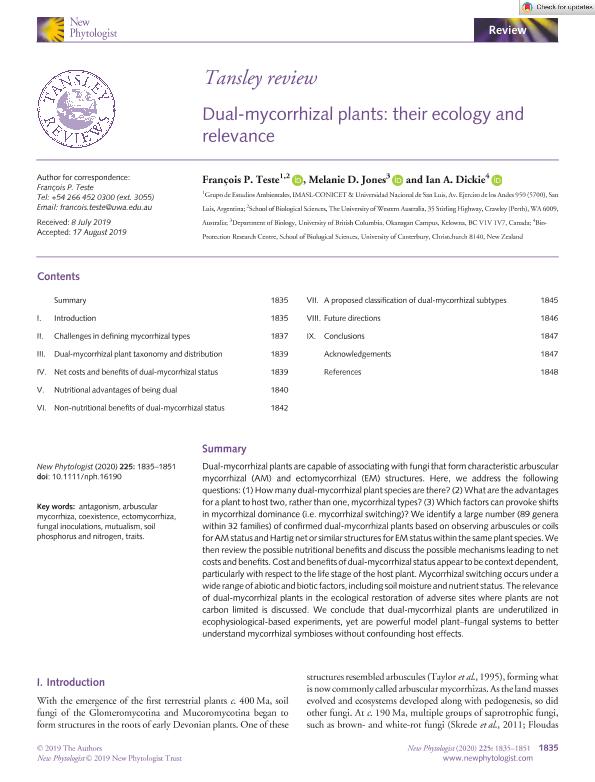Mostrar el registro sencillo del ítem
dc.contributor.author
Teste, Francois

dc.contributor.author
Jones, Melanie D.
dc.contributor.author
Dickie, Ian

dc.date.available
2021-07-20T12:24:24Z
dc.date.issued
2019-09
dc.identifier.citation
Teste, Francois; Jones, Melanie D.; Dickie, Ian; Dual‐mycorrhizal plants: their ecology and relevance; Wiley Blackwell Publishing, Inc; New Phytologist; 225; 5; 9-2019; 1835-1851
dc.identifier.issn
0028-646X
dc.identifier.uri
http://hdl.handle.net/11336/136479
dc.description.abstract
Dual-mycorrhizal plants are capable of associating with fungi that form characteristic arbuscular mycorrhizal (AM) and ectomycorrhizal (EM) structures. Here, we address the following questions: (1) How many dual-mycorrhizal plant species are there? (2) What are the advantages for a plant to host two, rather than one, mycorrhizal types? (3) Which factors can provoke shifts in mycorrhizal dominance (i.e. mycorrhizal switching)? We identify a large number (89 genera within 32 families) of confirmed dual-mycorrhizal plants based on observing arbuscules or coils for AM status and Hartig net or similar structures for EM status within the same plant species. We then review the possible nutritional benefits and discuss the possible mechanisms leading to net costs and benefits. Cost and benefits of dual-mycorrhizal status appear to be context dependent, particularly with respect to the life stage of the host plant. Mycorrhizal switching occurs under a wide range of abiotic and biotic factors, including soil moisture and nutrient status. The relevance of dual-mycorrhizal plants in the ecological restoration of adverse sites where plants are not carbon limited is discussed. We conclude that dual-mycorrhizal plants are underutilized in ecophysiological-based experiments, yet are powerful model plant–fungal systems to better understand mycorrhizal symbioses without confounding host effects.
dc.format
application/pdf
dc.language.iso
eng
dc.publisher
Wiley Blackwell Publishing, Inc

dc.rights
info:eu-repo/semantics/openAccess
dc.rights.uri
https://creativecommons.org/licenses/by-nc-sa/2.5/ar/
dc.subject
ANTAGONISM
dc.subject
ARBUSCULAR MYCORRHIZA
dc.subject
COEXISTENCE
dc.subject
ECTOMYCORRHIZA
dc.subject
FUNGAL INOCULATIONS
dc.subject
MUTUALISM
dc.subject
SOIL PHOSPHORUS AND NITROGEN
dc.subject
TRAITS
dc.subject.classification
Ecología

dc.subject.classification
Ciencias Biológicas

dc.subject.classification
CIENCIAS NATURALES Y EXACTAS

dc.title
Dual‐mycorrhizal plants: their ecology and relevance
dc.type
info:eu-repo/semantics/article
dc.type
info:ar-repo/semantics/artículo
dc.type
info:eu-repo/semantics/publishedVersion
dc.date.updated
2020-11-18T20:46:22Z
dc.journal.volume
225
dc.journal.number
5
dc.journal.pagination
1835-1851
dc.journal.pais
Reino Unido

dc.journal.ciudad
Londres
dc.description.fil
Fil: Teste, Francois. Consejo Nacional de Investigaciones Científicas y Técnicas. Centro Científico Tecnológico Conicet - San Luis. Instituto de Matemática Aplicada de San Luis "Prof. Ezio Marchi". Universidad Nacional de San Luis. Facultad de Ciencias Físico, Matemáticas y Naturales. Instituto de Matemática Aplicada de San Luis "Prof. Ezio Marchi"; Argentina. University of Western Australia; Australia
dc.description.fil
Fil: Jones, Melanie D.. University of British Columbia; Canadá
dc.description.fil
Fil: Dickie, Ian. University of Canterbury; Nueva Zelanda
dc.journal.title
New Phytologist

dc.relation.alternativeid
info:eu-repo/semantics/altIdentifier/doi/http://dx.doi.org/10.1111/nph.16190
dc.relation.alternativeid
info:eu-repo/semantics/altIdentifier/url/https://nph.onlinelibrary.wiley.com/doi/full/10.1111/nph.16190
Archivos asociados
